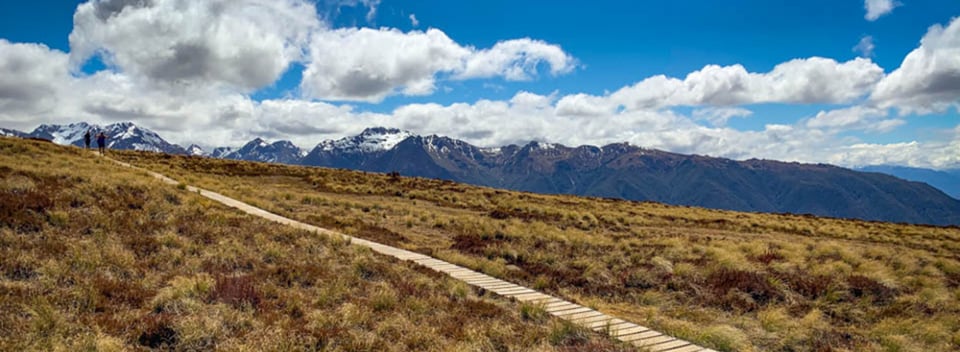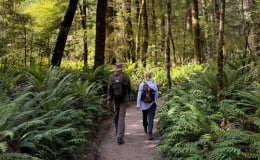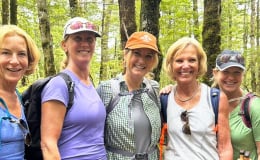
Hiking the Kepler Track in Winter | Weather Guide
The Kepler Track is a 60km (37 miles) hiking track in the heart of Fiordland National Park and is one of the ten Great Walks of New Zealand. It’s known for its fairytale-esque beech forest, dramatic mountain vistas, rolling tussockland and crystal clear lakes. The walk takes about 3 – 4 days to complete with plenty of huts to choose from along the way.
The most popular time to walk the track is summer (Dec-Feb), however it is possible to hike in the winter if you’re an advanced hiker with the right ability levels and expertise. For more info on the best times to hike in New Zealand check out our handy guide.
For those who may have seen it during Great Walks season (mid-October to early-April) the track takes on an entirely different persona in the winter months. Icicles start to from in the sub alpine forest before you break through the bushline into what used to be golden tussock plains and is now transformed by glistening white snow. The sharp, rocky ridgelines are now softened by the snow blanket that’s settled in for the winter.
There are nine avalanche paths to consider on a winter trip, and high attention to safety is essential.

In winter you might get bluebird skies but be prepared for a thick layer of pillow like snow.
Crowd Levels
Like many of our alpine hiking tracks in the winter, the Kepler Track is like a ghost town – a stark contrast from the summer months! You can expect there to be little-to-no hikers on the track, which can be bliss at times, however also means you need to be extra self-sufficient – there won’t be anyone nearby to borrow gas from or lend a hand if you get stuck!
Top tip: we highly recommend popping into the DoC (Department of Conservation) Fiordland National Park Visitor Centre before your hike, so someone knows your planned route and so they can give you the most up-to-date advice on track conditions.
If low crowd levels are a drawcard for you, the shoulder seasons in Autumn and Spring are also great times to visit the Kepler Track and are easier times to hike than the winter season. Generally in these two seasons people have gone back to work or school, the busy tourism season is over and the tracks empty out!
Bookings and costs
Outside of the Great Walks Season, bookings are not required on the Kepler Track. You do however, need a Backcountry Hut pass (from NZD $120 for six months) or Backcountry Hut ticket (from NZD $5 depending on what kind of hut you’re staying in) to stay in the huts along the track.
A super important thing to note about hut bookings through the winter is that their facilities are greatly reduced, meaning there’s no gas, flushing toilets are replaced with pit toilets, there is no running water and there are no hut wardens based at the huts.
Track transport options are also reduced during the winter months, with some operators shutting down their track transport completely. Other operators run reduced schedules, but sometimes no at all if a minimum number of people don’t book on. Track transport can start from around NZD $60. Your best and most reliable option would be to self-drive either in your own car or by renting one from Queenstown. Renting a car during winter in Queenstown starts from around NZD $120 per day and can be quite competitive due to all the skiers and snowboarders trying to get up our glorious mountains, so be sure to book well in advance!

Our guests crossing on of the many beautiful swing bridges on the Kepler Track.
Temperatures
Temperatures in Fiordland can get down to between 1 and 9 °C (34-48°F) in peak winter. You can expect rain in Fiordland at any time of the year – it gets a jaw dropping 7m (23ft) of rain per year, however, winter seems to be when it is at its most settled with clear skies. There are shorter daylight hours with the sun rising about 8.30am and setting at about 4.30pm and winter can be a great time to spot the Aurora Australis.
On the Kepler – especially in the alpine sections – high and gusty winds and snow are definitely on the cards, so it pays to be mindful of windchill and making sure you don’t get blown off a ridge! The snow can also blanket the track so it becomes unmarked and in the middle of snowfall, visibility is greatly reduced.

Make sure you're prepared for any and all weather conditions with the highly changeable alpine weather.
What to bring
In addition to your usual hiking gear (see our packing list) there are a few more essential winter items you’ll want to bring along.
At the top of your list when hiking the Kepler Track in the winter should be a beacon, a snow shovel and an avalanche probe, and you should be well-versed in using all of them!
For winter especially, crampons and an ice axe are a good idea.
With facilities being reduced at winter, it’s also important to remember your gas cooker, lighters/matches, and toilet paper.
You’ll also want:
- Food (an extra two days food is recommended)
- Warm and waterproof clothing
- Warm sleeping bag
- Survival blanket
- Torch
- Sunglasses
- Sunscreen
- First aid kit
- Personal locator beacon
- Mountain radio or satellite messenger (optional)
Skip the logistics!
Winter can make for some challenging conditions, an excellent arena for experienced winter hikers to explore, but dangerous for the vast majority. If you are going to hike the Kepler in Track be sure to be prepared and take the utmost care.
However, there are lots of one-day hiking options which are perfect for those not quite ready to tackle the winter terrain yet! You’ll still get to enjoy some of the best parts of the track without all the extra logistics.
Consider hiking:
- Kepler Carpark to Brod Bay (1.5 hours, xxx), you can also leave from Rainbow reach and lengthen the walk by about xx hours.
- Rainbow Reach to Moturau Hut or Shallow Bay (1.5 hours, xxx) you can also leave from Kepler Carpark.
Alternatively, if you’d prefer better weather and for someone else to handle the logistics we visit the Kepler Track on our all of our New Zealand hiking tours on the South Island.
On our The New Zealand Great Walk Adventure, you do the Kepler style, taking a helicopter to Luxmore Hut and hiking back down! You also get to sample three other Great Walks of New Zealand in the same trip!

A cheeky native Kea at Luxmore Hut on the Kepler Track.
FAQS
Can you hike the Kepler Track in winter?
Yes, with the right experience, equipment and expertise. The Kepler Track is open year round with reduced facilities. Make sure you check in with the DoC visitor centre before departing to get the most up-to-date information on track conditions.
How long does it take to hike the Kepler Track?
It usually takes about 3-4 days if you are staying in huts, if you are exclusively camping, because there are only two campsites you’ll need to do it in 2-3 days which is a good challenge!
When is the best time to hike the Kepler Track?
During Great Walks season (late-October to mid-April) is the best time to hike the Kepler Track. There’s still a good chance of nice weather and facilities are still being maintained. There are also still DoC hut wardens nearby to help out with anything you might need. It’s also a great time to meet like-minded travellers! If you’re looking to avoid the crowds you can still do this in shoulder seasons (October-November and March-April).
If you'd like to find out more about our New Zealand guided hiking tours grab a copy of our FREE BROCHURE or get in touch. We always love to chat!







